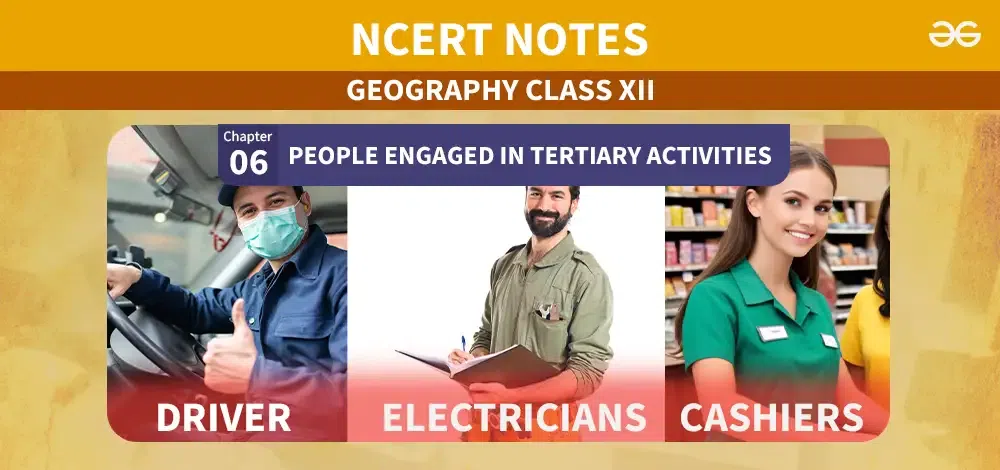People Engaged in Tertiary Activities| Class 12 Geography Notes
Last Updated :
03 May, 2024
People engaged in tertiary activities, whether skilled professionals or unskilled workers form the backbone of service-based sectors. From healthcare to hospitality, their contributions ensure the functioning of essential services that enhance societal well-being and economic growth. Tertiary sector employment includes a wide range of roles, from doctors and teachers to hospitality staff and transportation personnel.
In this article, we will look into the tertiary sector and people engaged in tertiary activities with some selected examples. It is an important concept of Class 12 Geography. Students can go through this article to get comprehensive notes on “People Engaged in Tertiary Activities”.

People Engaged in Tertiary Activities| Class 12 Geography Notes
People Engaged in Tertiary Activities
Tertiary activities are related to the service sector and involve specialized skills, experience, and knowledge of workers. Professionals in this sector, such as doctors, lawyers, teachers, and consultants, require specific expertise to deliver their services. Some examples of tertiary activities include Transportation, Education, Health, Personal services, and Social Services. It is the largest and fastest-growing sector in many countries.
The service sector in India contributes over 60% of the country’s GDP but only employs 25% of the labour force. In developed countries, a higher percentage of people are engaged in the service sector than in less developed countries. As compared to primary and secondary sectors, nowadays, more people are engaging in the service sector.
Some Selected Examples
The service sector, also known as the tertiary sector, is one of the three sectors of the economic sector. Selected examples of tertiary activities include tourism, which drives economic growth and creates employment opportunities, and medical tourism, offering specialized healthcare services to international patients. These are explained in detail below:
Tourism as a Tertiary Activity
- Tourism constitutes a significant tertiary activity, consisting of recreational travel and leisure.
- It has become the world’s single largest tertiary activity.
- It boasts the highest number of registered jobs and contributes a substantial portion to global GDP.
- Tourism generates employment opportunities in various sectors such as accommodation, transportation, and entertainment.
Economic Impact of Tourism
- Tourism stimulates economic growth by fostering the development of infrastructure, retail, and craft industries.
- It provides employment opportunities to the local people of the region.
- It plays an important role in promoting regional development, particularly in areas with popular tourist destinations.
- Seasonal variations exist in tourism due to weather-dependent vacation periods, with some regions attracting visitors year-round.
Tourist Attractions
- Climate is a significant factor influencing tourist preferences, with warmer regions often attracting visitors seeking sunny weather.
- Scenic landscapes, historic sites, and cultural heritage also draw tourists, contributing to the appeal of destinations.
- Regions like the Mediterranean Coast and the West Coast of India are renowned tourist destinations due to their favorable climate and scenic beauty.
- Winter sports regions in mountainous areas and national parks also attract visitors seeking outdoor recreation and adventure.
Emergence of Medical Tourism
- India has emerged as a leading destination for medical tourism, attracting patients from around the world seeking affordable healthcare services.
- World-class hospitals in metropolitan cities cater to international patients, offering specialized medical treatments and procedures.
- Medical tourism not only benefits patients but also contributes to the economies of developing countries like India, Thailand, and Malaysia.
Outsourcing in Healthcare
- Beyond medical tourism, there is a trend of outsourcing medical services such as reading radiology images and interpreting medical tests.
- Hospitals in various countries offer outsourcing services, providing specialized care and improving healthcare quality for patients globally.
Integration of Tourism and Healthcare
- Medical tourism combines medical treatment with international tourism activities, leading to the concept of medical tourism.
- This integration offers patients the opportunity to access quality healthcare services while experiencing tourism activities in a foreign destination.
Importance of Tertiary Activities
The importance of the tertiary activities includes:
- Tertiary activities provide essential services important for societal functioning.
- They drive economic growth by creating employment opportunities.
- Tertiary sector contributes significantly to GDP, particularly in developed countries.
- Services like healthcare, education, and hospitality enhance quality of life.
- Tertiary activities facilitate global connectivity and exchange of information.
- Tertiary activities promote specialization and expertise in various fields.
- Tertiary activities support other sectors by providing necessary infrastructure and support services
Conclusion – People Engaged in Tertiary Activities
In conclusion, those engaged in tertiary activities, whether skilled or unskilled, are crucial for delivering essential services that drive economic growth and enhance societal well-being. Skilled professionals, like doctors and engineers, contribute expertise to sectors such as healthcare and infrastructure development. Meanwhile, unskilled workers, including hospitality and transportation staff, ensure the smooth delivery of services like accommodation and transportation, collectively forming the backbone of the tertiary sector. Their combined efforts help in shaping modern societies and meeting diverse societal needs.
People Also View:
People Engaged in Tertiary Activities- FAQs
What are people engaged in tertiary activities?
People involved in tertiary activities include Plumbers, Electricians, Technicians, Launderers, Barbers, Shopkeepers, Drivers, Cashiers, Teachers, and Lawyers.
What percentage of the population is engaged in tertiary sector in India?
According to the CSO, 26.9% of India’s population is engaged in the tertiary sector, also known as the services sector.
Why are people engaged in tertiary activities?
People engage in tertiary activities to provide essential services that drive economic growth and enhance societal well-being.
What activities are coming under tertiary activities?
Tertiary activities includes services such as healthcare, education, hospitality, transportation, communications, finance, and professional services.
Why most of the people are engaged in tertiary sector?
Most people are engaged in the tertiary sector due to the increasing demand for services, driven by societal needs, technological advancements, and economic growth.
What is a tertiary activity?
Tertiary activities are activities that support the primary and secondary sectors of the economy through services rather than the production of goods.
Share your thoughts in the comments
Please Login to comment...